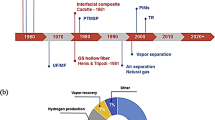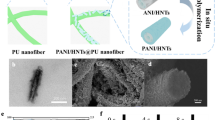Abstract
In this study, poly(vinylidene fluoride) (PVDF) dual-layer hollow-fiber UF membranes were prepared via phase inversion in one step. Laboratory-synthesized amphiphilic poly(vinylidene fluoride)-g-poly(ethylene glycol) methyl ether methacrylate (PVDF-g-POEM) was incorporated as a hydrophilic modifier of the outer layer by blending. The effects of the dope formulation and membrane formation conditions on membrane structure and UF performance were investigated. The parameters investigated included the PVDF-g-POEM loading in the outer layer, the PEG additive content in the outer layer, the external coagulant composition, and the polymer concentration in the inner layer. The effects of adding PVDF-g-POEM and PEG were found to depend on the external coagulant composition; when a water/ethanol mixture was used as coagulant, the fibers formed in the presence of PEG exhibited larger pores, as confirmed by both SEM characterization and a solute rejection method. The porosity of the inner layer was observed to increase with decreasing inner-layer dope concentration and upon weakening the external coagulant. A more porous inner layer led to a higher transmembrane pure water flux. An antifouling test confirmed that both membrane hydrophobicity and surface pore size affected the membrane fouling pattern and the final FRR. The highest FRR of 83.3% was obtained with the hollow fiber M5A, which was characterized by a compact surface and contained PVDF-g-POEM in its polymer matrix.













Similar content being viewed by others
References
Drioli E, Giorno L (2012) Basic aspects of membrane science and engineering. Science Press, Beijing
Hilal N, Ogunbiyi OO, Miles NJ, Nigmatullin R (2005) Methods employed for control of fouling in MF and UF membranes: a comprehensive review. Sep Sci Technol 40:1957–2005
Van der Bruggen B, Mänttäri M, Nyström M (2008) Drawbacks of applying nanofiltration and how to avoid them: a review. Sep Purif Technol 63:251–263
Zheng X (2016) Report for sustainable development strategy of China water treatment industry. Renmin University Press, Beijing
Luo L, Han G, Chung TS, Weber M, Staudt C, Maletzko C (2015) Oil/water separation via ultrafiltration by novel triangle-shape tri-bore hollow fiber membranes from sulfonated polyphenylenesulfone. J Membr Sci 476:162–170
Kang S, Asatekin A, Mayes AM, Elimelech M (2007) Protein antifouling mechanisms of PAN UF membranes incorporating PAN-g-PEO additive. J Member Sci 296:42–50
Yang MC, Lin WC (2002) The grafting of chitosan oligomer to polysulfone membrane via ozone treatment and its effect on antibacterial activity. J Polym Res 9:135–140
Amirilargani M, Sadrzadeh M, Mohammadi T (2010) Synthesis and characterization of polyethersulfone membranes. J Polym Res 17:363–377
Buonomenna MG, Macchi P, Davoli M, Drioli E (2007) Poly(vinylidene fluoride) membranes by phase inversion: the role the casting and coagulation conditions play in their morphology, crystalline structure and properties. Eur Polym J 43:1557–1572
Song ZW, Jiang LY (2013) Optimization of morphology and performance of PVDF hollow fiber for direct contact membrane distillation using experimental design. Chem Eng Sci 101:130–143
Zhang PY, Yang H, Xu ZL, Wei YM, Guo JL, Chen DG (2013) Characterization and preparation of poly(vinylidene fluoride) (PVDF) microporous membranes with interconnected bicontinuous structures via non-solvent induced phase separation (NIPS). J Polym Res 20:66–78
Wang DM, Lai JY (2013) Recent advances in preparation and morphology control of polymeric membranes formed by nonsolvent induced phase separation. Curr Opin Chem Eng 2:229–237
Hester JF, Banerjee P, Won YY, Akthakul A, Acar MH, Mayes AM (2002) ATRP of amphiphilic graft copolymers based on PVDF and their use as membrane additives. Macromolecules 35:7652–7661
Zhao YP, Bai JN, Feng X, Chen L, Shen X, Liu MJ, Li JX (2013) Properties of poly(vinylidene fluoride)-graft-poly(N-isopropylacrylamide) membranes prepared by alkali treatment. J Polym Res 22:32–39
Bahader A, Gui HG, Fang HG, Wang P, Wu SJ, Ding YS (2016) Preparation and characterization of poly(vinylidene fluoride) nanocomposites containing amphiphilic ionic liquid modified multiwalled carbon nanotubes. J Polym Res 23:184–192
Liang S, Kang Y, Tiraferri A, Giannelis EP, Huang X, Elimelech M (2013) Highly hydrophilic polyvinylidene fluoride (PVDF) ultrafiltration membranes via postfabrication grafting of surface-tailored silica nanoparticles. ACS Appl Mater Interfaces 5:6694–6703
Tang YP, Chan JX, Chung TS, Weber M, Staudt C, Maletzko C (2015) Simultaneously covalent and ionic bridging towards antifouling of GO-imbedded nanocomposite hollow fiber membranes. J Mater Chem A 3:10573–10584
Lafrenière LY, Talbot FDF, Matsuura T, Sourirajan S (1987) Effect of poly(vinylpyrrolidone) additive on the performance of poly(ether sulfone) ultrafiltration membranes. Ind Eng Chem Res 26:2385–2389
Li Q, Bi QY, Lin HH, Bian LX, Wang XL (2013) A novel ultrafiltration (UF) membrane with controllable selectivity for protein separation. J Membr Sci 427:155–167
Abed MRM, Kumbharkar SC, Groth AM, Li K (2013) Economical production of PVDF-g-POEM for use as a blend in preparation of PVDF based hydrophilic hollow fibre membranes. Sep Purif Technol 106:47–55
Rajasekhar T, Trinadh M, Babu PV, Sainath AVS, Reddy AVR (2015) Oil–water emulsion separation using ultrafiltration membrane based on novel blends of poly(vinylidene fluoride) and amphiphilic tri-block copolymer containing carboxylic acid functional group. J Member Sci 481:82–93
Liu F, Xu YY, Zhu BK, Zhang F, Zhu LP (2009) Preparation of hydrophilic and fouling resistant poly(vinylidene fluoride) hollow fiber membranes. J Membr Sci 345:331–339
Koh JK, Yong WK, Ahn SH, Min BR, Kim JH (2010) Antifouling poly(vinylidene fluoride) ultrafiltration membranes containing amphiphilic comb polymer additive. J Polym Sci B Polym Phys 48:183–189
Shen JL, Zhang Q, Yin Q, Cui ZL, Li WX, Xing WH (2017) Fabrication and characterization of amphiphilic PVDF copolymer ultrafiltration membrane with high anti-fouling property. J Member Sci 521:95–103
Yang J, Li DW, Lin YK, Wang XL, Tian F, Wang Z (2008) Formation of a bicontinuous structure membrane of polyvinylidenefluoride in diphenyl ketone diluent via thermally induced phase separation. J Appl Polym Sci 110:341–347
Li Y, Chung TS (2008) Exploration of highly sulfonated polyethersulfone (SPES) as a membrane material with the aid of dual-layer hollow fiber fabrication technology for protein separation. J Membr Sci 309:45–55
Widjojo N, Chung TS, Krantz WB (2007) A morphological and structural study of Ultem/P84 copolyimide dual-layer hollow fiber membranes with delamination-free morphology. J Membr Sci 294:132–146
Turner JE, Shen M, Lin C (1980) Hydrophilic behavior of HSPAN/PVA membrane. J Appl Polym Sci 25:1287–1296
Jonquières A, Clément R, Lochon P, Néel J, Dresch M, Chrétien B (2002) Industrial state-of-the-art of pervaporation and vapour permeation in the Western countries. J Membr Sci 206:87–117
Zhu JM, Jiang LY, Matsuura T (2015) New insights into fabrication of hydrophobic/hydrophilic composite hollow fibers for direct contact membrane distillation. Chem Eng Sci 137:79–90
Li NN, Xiao CF, An SL, Hu XY (2010) Preparation and properties of PVDF/PVA hollow fiber membranes. Desalination 250:530–537
Linares A, Nogales A, Rueda DR, Ezquerra TA (2007) Molecular dynamics in PVDF/PVA blends as revealed by dielectric loss spectroscopy. J Polym Sci 45:1653–1661
Feng X, Jiang LY, Matsuura T, Wu P (2017) Fabrication of hydrophobic/hydrophilic composite hollow fibers for DCMD: influence of dope formulation and external coagulant. Desalination 401:53–63
Li SW, Cui ZY, Zhang L, He BQ, Li JX (2016) The effect of sulfonated polysulfone on the compatibility and structure of polyethersulfone-based blend membranes. J Membr Sci 513:1–11
Wang KY, Matsuura T, Chung TS, Guo WF (2004) The effects of flow angle and shear rate within the spinneret on the separation performance of poly(ethersulfone) (PES) ultrafiltration hollow fiber membranes. J Membr Sci 240:67–79
Meireles M, Bessieres A, Rogissart I, Aimar P, Sanchez V (1995) An appropriate molecular size parameter for porous membranes calibration. J Membr Sci 103:105–115
de Sa TGL, Riaño JA, Garrido LM (1988) Conformational transition of polyvinylpyrrolidone in aqueous solutions of sodium dodecylsulphate. Eur Polym J 24:493–496
Michaels AS (1980) Analysis and prediction of sieving curves for ultrafiltration membranes: a universal correlation. Sep Sci Technol 15:1305–1322
Cooper AR, Derveer DSV (1979) Characterization of ultrafiltration membranes by polymer transport measurement. Sep Sci Technol 14:551–556
Ishiguro M, Matsuura T, Detellier C (1996) A study on the solute separation and the pore size distribution of a montmorillonite membrane. Sep Sci Technol 31:545–556
Youm KH, Kim WS (1991) Prediction of intrinsic pore properties of ultrafiltration membrane by solute rejection curves: effect of operating conditions on pore properties. J Chem Eng Jpn 24:1–7
Choi H, Kwon Y, Jung Y, Hong S, Tak T (2012) Preparation and characterization of antifouling poly(vinylidene fluoride) blended membranes. J Appl Polym Sci 123:286–291
Bonyadi S, Chung TS (2007) Flux enchancement in membrane distillation by fabrication of dual layer hydrophilic-hydrophobic hollow fiber membranes. J Membr Sci 306:134–146
Deshmukh SP, Li K (1998) Effect of ethanol composition in water coagulation bath on morphology of PVDF hollow fibre membranes. J Membr Sci 150:75–85
Wang DL, Li K, Teo WK (1999) Preparation and characterization of polyvinylidenefluoride (PVDF) hollow fiber membranes. J Membr Sci 163:211–220
Boom RM, Wienk IM, Boomgaard TVD, Smolders CA (1992) Microstructure in phase inversion membranes part 2: the role of a polymeric additive. J Membr Sci 73:277–292
Feng CY, Khulbe KC, Chowdhury G, Matsuura T, Sapkal VC (2001) Structural and performance study of microporous polyetherimide hollow fiber membranes made by solvent-spinning method. J Membr Sci 189:193–203
Widjojo N, Chung TS, Kulprathipanja S (2008) The fabrication of hollow fiber membranes with double-layer mixed-matrix materials for gas separation. J Membr Sci 325:226–335
Lin CF, Lin AYC, Chandana PS, Tsai CY (2009) Effects of mass retention of dissolved organic matter and membrane pore size on membrane fouling and flux decline. Water Res 43:389–394
Lin YK, Tang YH, Ma HY, Yang J, Tian Y, Ma WZ, Wang XL (2009) Formation of a bicontinuous structure membrane of polyvinylidenefluoride in diphenyl carbonate diluent via thermally induced phase separation. J Appl Polym Sci 114:1523–1528
Zhang JG, Xu ZW, Mai W, Min CY, Zhou BM, Shan MJ, Li YL, Yang CY, Wang Z, Qian XM (2013) Improved hydrophilicity, permeability, antifouling and mechanical performance of PVDF composite ultrafiltration membranes tailored by oxidized low dimensional carbon nanomaterials. J Mater Chem A 1:3101–3111
Acknowledgements
The authors would like to thank the National Natural Science Foundation of China (project no. 21176265), the Hunan Provincial Science and Technology Plan (project no. 2014GK3106), and the Chinese National Project for Overseas Experts in Culture, Education, and Public Health (account no. 140010001).
Author information
Authors and Affiliations
Corresponding author
Electronic supplementary material
ESM 1
(PPTX 349 kb)
Rights and permissions
About this article
Cite this article
Song, Y., Jiang, L.Y. Fabrication and characterization of dual-layer hollow-fiber ultrafiltration membranes. J Polym Res 24, 121 (2017). https://doi.org/10.1007/s10965-017-1271-y
Received:
Accepted:
Published:
DOI: https://doi.org/10.1007/s10965-017-1271-y




